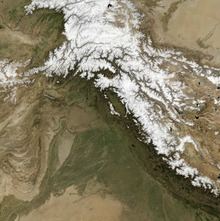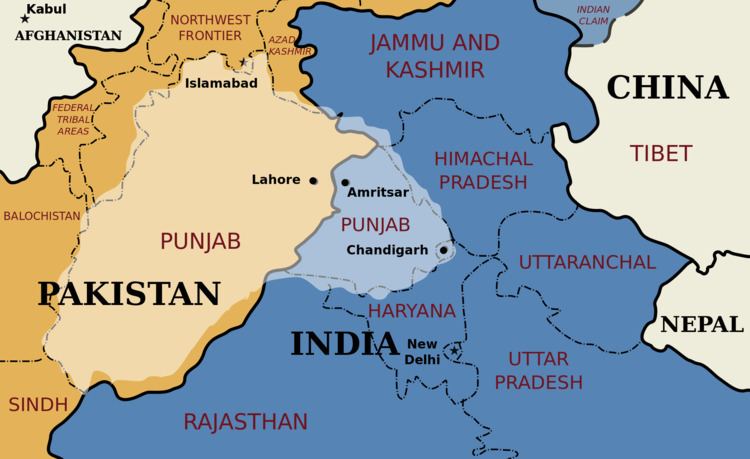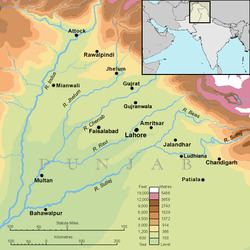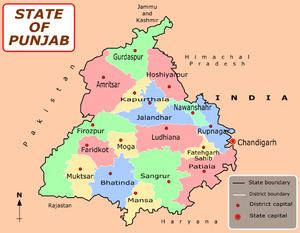Largest cities see list | ||
 | ||
Areas various definitions see below | ||
The Punjab (/pʌnˈdʒɑːb/, /ˈpʌndʒɑːb/, /pʌnˈdʒæb/, /ˈpʌndʒæb/), also spelled Panjab, panj-āb, land of "five rivers" (Punjabi: پنجاب ਪੰਜਾਬ , is a geographical and cultural region in the northern part of South Asia, comprising areas of eastern Pakistan and northern India. Not being a political unit, the extent of the region is the subject of debate and focuses on historical events to determine its boundaries.
Contents
- Etymology
- Physical geography
- Climate
- History
- Timeline
- Ethnic background
- Languages
- Religions
- Punjabi festivals
- Punjabi clothing
- Economy
- References

The Punjab region has been inhabited by Indus Valley Civilisation, Indo-Aryan peoples, Indo-Scythians and has seen numerous invasions by the Achaemenid Empire, Greeks, Kushan Empire, Ghaznavids, Timurids, Mughals, Afghans, British and others. The foreign invaders mainly targeted the most productive region of Punjab known as the Majha region, located in central part of Punjab, which is also the bedrock of Panjabi culture and traditions. The people of the Punjab today are called Punjabis and their principal language is called Punjabi. The main religions of the Punjab region are Islam, Sikhism and Hinduism. Other religious groups are Christianity, Jainism and Buddhism.

Etymology

The name of the region is a compound of two Persian words Panj (five) and āb (water) and was introduced to the region by the Turko-Persian conquerors of India and more formally popularised during the Mughal Empire. Punjab literally means "(The Land of) Five Waters" referring to the rivers: Jhelum, Chenab, Ravi, Sutlej, and Beas. All are tributaries of the Indus River, the Chenab being the largest.
Physical geography

There are two main definitions of the Punjab region: the 1947 definition and the older 1846-1849 definition. The third definition incorporates both the 1947 and the older definitions but also includes northern Rajasthan on a linguistic basis and ancient river movements.

The 1947 definition defines the Punjab region with reference to the dissolution of British India whereby the then British Punjab Province was partitioned between India and Pakistan. In Pakistan, the region now includes the Punjab province and Islamabad Capital Territory. In India, it includes the Punjab state, Chandigarh, Haryana and Himachal Pradesh.

Using the 1947 definition, the Punjab region borders Kashmir to the north, Sindh and Rajasthan to the south, the Pashtun region and Balochistan to the west, and the Hindi belt to the east. Accordingly, the Punjab region is very diverse and stretches from the hills of the Kangra Valley to the plains and to the Cholistan Desert.
Using the 1947 definition of the Punjab region, some of the major cities of the area include Lahore, Faisalabad and Ludhiana.
The older definition of the Punjab region focuses on the collapse of the Sikh Empire and the creation of the British Punjab province between 1846 and 1849. According to this definition, the Punjab region incorporates, in Pakistan, Azad Kashmir including Bhimber and Mirpur and parts of Khyber Pakhtunkhwa (especially Peshawar known in the Punjab region as Pishore). In India the wider definition includes parts of Delhi and Jammu Division.
Using the older definition of the Punjab region, the Punjab region covers a large territory and can be divided into five natural areas:
The formation of the Himalayan Range of mountains to the east and north-east of the Punjab is the result of a collision between the north-moving Indo-Australian Plate and the Eurasian Plate. The plates are still moving together, and the Himalayas are rising by about 5mm per year.
The upper regions are snow-covered the whole year. Lower ranges of hills run parallel to the mountains. The Lower Himalayan Range runs from north of Rawalpindi through Jammu and Kashmir, Himachal Pradesh and further south. The mountains are relatively young, and are eroding rapidly. The Indus and the five rivers of the Punjab have their sources in the mountain range and carry loam, minerals and silt down to the rich alluvial plains, which consequently are very fertile.
According to the older definition, some of the major cities include Jammu, Peshawar and parts of Delhi.
The third definition of the Punjab region adds to the definitions cited above and includes parts of Rajasthan on linguistic lines and taking into consideration the location of the Punjab rivers in ancient times. In particular, the Sri Ganganagar and Hanumangarh districts are included in the Punjab region.
Climate
The climate is a factor contributing to the economy of the Punjab. It is not uniform over the whole region, with the sections adjacent to the Himalayas receiving heavier rainfall than those at a distance.
There are three main seasons and two transitional periods. During the Hot Season, from about mid April to the end of June, the temperature may reach 49˚C. The Monsoon Season, from July to September, is a period of heavy rainfall, providing water for crops in addition to the supply from canals and irrigation systems. The transitional period after the monsoon is cool and mild, leading to the Winter Season, when the temperature in January falls to 5˚C at night and 12˚C by day. During the transitional period from Winter to the Hot Season sudden hailstorms and heavy showers may occur, causing damage to crops.
History
The Punjab region of India and Pakistan has a historical and cultural link to Indo-Aryan peoples as well as partially to various indigenous communities. As a result of several invasions from Central Asia and the Middle East, many ethnic groups and religions make up the cultural heritage of the Punjab.
In prehistoric times, one of the earliest known cultures of South Asia, the Indus Valley Civilisation was located in the region.
The epic battles described in the Mahabharata are described as being fought in what is now the present-day State of Haryana and historic Punjab. The Gandharas, Kambojas, Trigartas, Andhra, Pauravas, Bahlikas (Bactrian settlers of the Punjab), Yaudheyas and others sided with the Kauravas in the great battle fought at Kurukshetra. According to Dr Fauja Singh and Dr L. M. Joshi: "There is no doubt that the Kambojas, Daradas, Kaikayas, Andhra, Pauravas, Yaudheyas, Malavas, Saindhavas and Kurus had jointly contributed to the heroic tradition and composite culture of ancient Punjab".
In 326 BCE, Alexander the Great invaded Pauravas and defeated King Porus. His armies entered the region via the Hindu Kush in northwest Pakistan and his rule extended up to the city of Sagala (present-day Sialkot in northeast Pakistan). In 305 BCE the area was ruled by the Maurya Empire. In a long line of succeeding rulers of the area, Chandragupta Maurya and Ashoka stand out as the most renowned. The Maurya presence in the area was then consolidated in the Indo-Greek Kingdom in 180 BCE. Menander I Soter "The Saviour" (known as Milinda in Indian sources) is the most renowned leader of the era, he conquered the Punjab and made Sagala the capital of his Empire. Menander carved out a Greek kingdom in the Punjab and ruled the region till his death in 130 B.C. The neighbouring Seleucid Empire rule came to an end around 12 BCE, after several invasions by the Yuezhi and the Scythian people.
In 711–713 CE, 18-year-old Arab Sultan Muhammad bin Qasim of Taif, a city in what is now Saudi Arabia, came by way of the Arabian Sea with Arab troops to defeat Raja Dahir. The Sultan then led his troops to conquer the Sindh and Punjab regions for the Islamic Umayyad Caliphate. Qasim was the first to bring Islam to the region.
During the establishment and consolidation of the Muslim Turkic Mughal Empire prosperity, growth, and relative peace were established. Particularly under the reign of Jahangir. Muslim empires ruled the Punjab for approximately 1000 years. The period was also notable for the emergence of Guru Nanak (1469–1539), the founder of Sikhism.
In 1758, Punjab came under the rule of Marathas who captured the region by defeating Afghan forces of Ahmad Shah Abdali. Abdali's Indian invasion weakened the Maratha influence, but he could not defeat the Sikhs. After the death of Ahmad Shah, the Punjab was freed from the Afghan yoke by Sikhs between 1773 and 1818. At the time of the formation of the Dal Khalsa in 1748 at Amritsar, the Punjab had been divided into 36 areas and 12 separate Sikh principalities, called misl. From this point onward, the beginnings of a Punjabi Sikh Empire emerged. Out of the 36 areas, 22 were united by Maharaja Ranjit Singh. The other 14 accepted British sovereignty. After Ranjit Singh's death, assassinations and internal divisions severely weakened the empire. Six years later the British East India Company was given an excuse to declare war and in 1849, after two Anglo-Sikh wars, the Punjab was annexed by the British.
In the Indian Rebellion of 1857 the Sikh rulers backed the East India Company, providing troops and support, but in Jhelum 35 British soldiers of HM XXIV regiment were killed by the local resistance and in Ludhiana a rebellion was crushed with the assistance of the Punjab chiefs of Nabha and Malerkotla.
The British Raj had political, cultural, philosophical and literary consequences in the Punjab, including the establishment of a new system of education. During the independence movement, many Punjabis played a significant role, including Madan Lal Dhingra, Sukhdev Thapar, Ajit Singh Sandhu, Bhagat Singh, Udham Singh, Kartar Singh Sarabha, Bhai Parmanand, Muhammad Iqbal, Chaudhary Rehmat Ali, and Lala Lajpat Rai.
At the time of partition in 1947, the province was split into East and West Punjab. East Punjab (48%) became part of India, while West Punjab (52%) became part of Pakistan. The Punjab bore the brunt of the civil unrest following the British Raj, with casualties estimated to be in millions.
Timeline
Ethnic background
Ethnic ancestries of modern Punjabis include a mixture of Indo-Aryan and Indo-Scythian. Semitic ancestries can also be found in lesser numbers. With the advent of Islam, settlers from Turkestan, Afghanistan, and Kashmir have also integrated into the Muslim Punjabi society. However the majority of Punjab is still made up of the Ahirs, Arains, Dalits (mostly Chamars), Gujjars, Jats, Khatris, Tarkhans, Brahmins, Bhats, Rajputs, Rors and Saini. In the past, the most densely populated area has been the Majha region of Punjab.
Languages
The major language spoken in the Punjab is Punjabi. In the Indian Punjab this is written in the Gurmukhi script. Pakistan uses the Shahmukhi script, that is closer to Urdu script. Hindi, written in the Devanagri script, is used widely in the Indian states of Himanchal Pradesh and Haryana. Several dialects of Punjabi are spoken in the different regions. The Majhi dialect is considered to be textbook Punjabi and is shared by both countries.
Religions
The vast majority of Pakistani Punjabis are Sunni Muslim by faith, but also include large minority faiths mostly Shia Muslim, Ahmadi Muslim and Christians.
The Indian states of Haryana and Himachal Pradesh are mostly Hindu-majority. Sikhism, founded in the late 15th century, is the main religion practised in the post-1966 Indian Punjab state. About 60% of the population of Punjab state is Sikh, 37% is Hindu, and the rest are Muslims, Christians, and Jains. However, due to large scale migration from Uttar Pradesh, Rajasthan, Bihar, Bengal and Odisha the demographics have become more skewed than reported earlier. Punjab state contains the holy Sikh cities of Amritsar, Anandpur Sahib, Tarn Taran Sahib, Fatehgarh Sahib and Chamkaur Sahib.
The Punjab was home to several Sufi saints. Sufism is a concept in Islam. Also, Kirpal Singh revered the Sikh Gurus as saints.
Punjabi festivals
Punjabis celebrate the following cultural, seasonal and religious festivals:
Punjabi clothing
Traditional Punjabi clothing includes the following:
Economy
The historical region of Punjab is considered to be one of the most fertile regions on Earth. Both east and west Punjab produce a relatively high proportion of India and Pakistan's food output respectively.
The region has been used for extensive wheat farming, in addition rice, cotton, sugarcane, fruit and vegetables are also grown.
The agricultural output of the Punjab region in Pakistan contributes significantly to Pakistan's GDP. Both Indian and Pakistani Punjab are considered to have the best infrastructure of their respective countries. Indian Punjab has been estimated to be the second richest state in India. Pakistani Punjab produces 68% of Pakistan's food grain production. Its share of Pakistan's GDP has historically ranged from 51.8% to 54.7%.
Called "The Granary of India" or "The Bread Basket of India", Indian Punjab produces 1% of the world's rice, 2% of its wheat, and 2% of its cotton. In 2001, it was recorded that farmers made up 39% of Indian Punjab's workforce.
